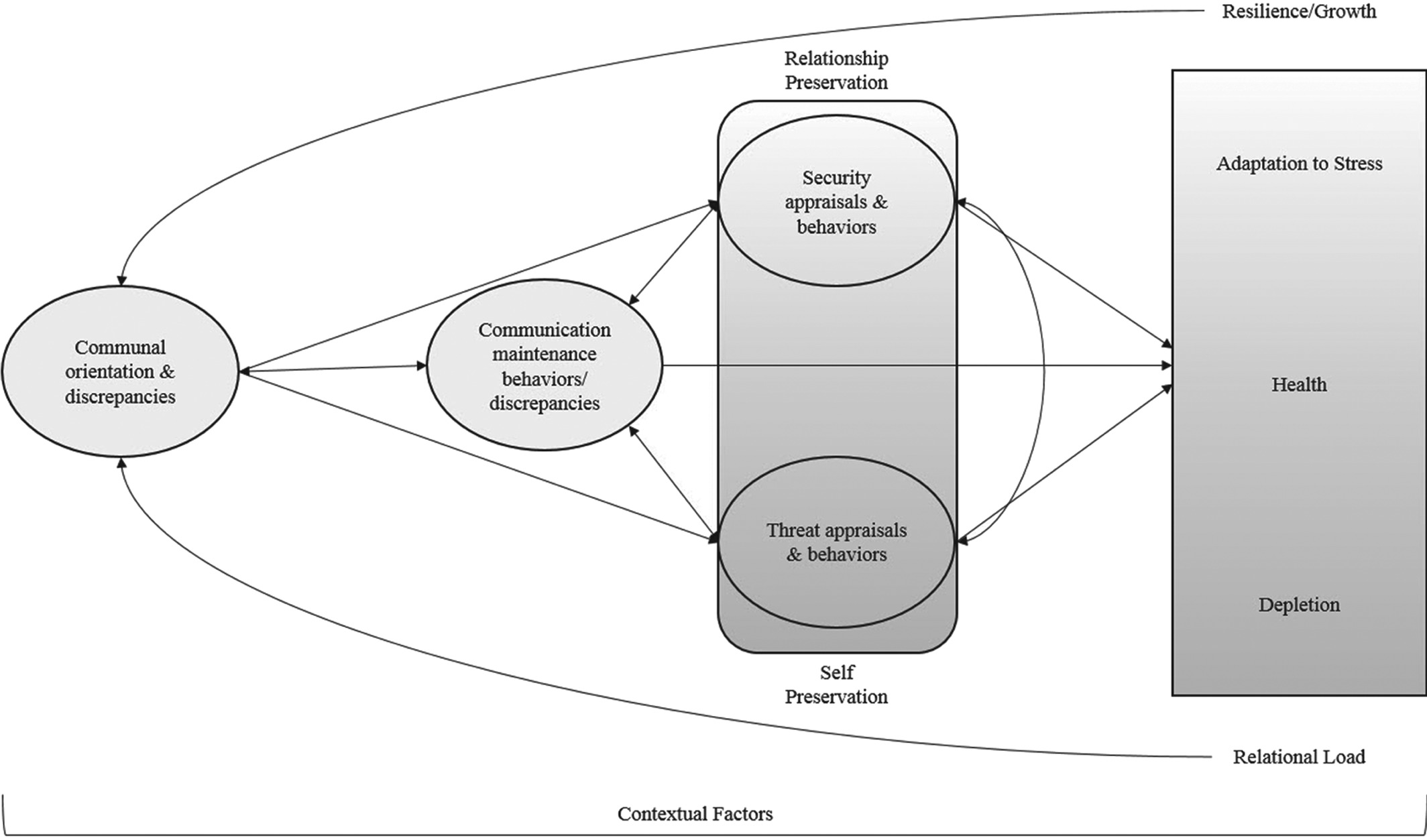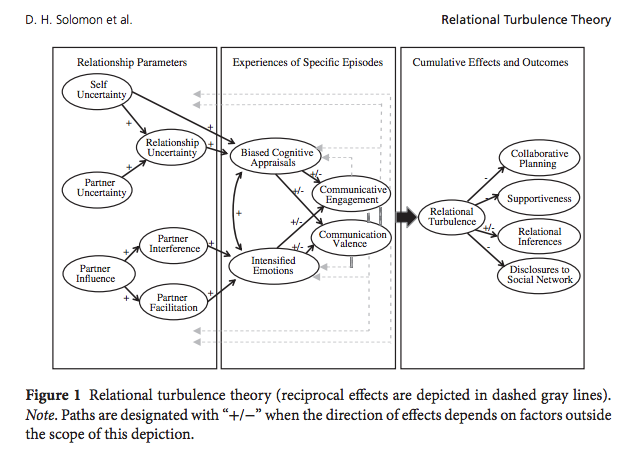5 Relationship Centered
5.3 Resilience Communication Theories
Human resilience is “the ability to”bounce back" or reintegrate after difficult life experiences"
-
Resilience is not possessed by individual but by discourse, interaction, and processes:
crafting normalcy
-
affirming identity anchors:
- identity anchor is “a relatively enduring cluster of identity discourses upon which individuals and their familial, collegial, and/or community members rely when explaining who they are for themselves and in relation to each other.”
-
maintaining and using communication networks
- Social capital is important in time of need
putting alternative logics to work
downplaying negative feelings while foregrounding positive emotions
-
(Richardson 2002) defines resilience as “the process of reintegrating from disruptions in life”
- requires “trigger event”
(AFIFI, MERRILL, and DAVIS 2016)
-
Theory of resilience and relational load (TRRL) in the context of social
-
based on theory of
emotional capital
adaptive calibration model, allostatic load, investment model, family systems theory, affectionate exchange theory, broaden and build theory
-
Assumptions
people want to feel validated and secure, based on sociometer hypothesis, intergroup theories, social identity theory, evolutionary theories (e.g., exchange theory).
-
stress is natural and necessary (either good or bad).
good stress = positive perception of stressors
bad stress = distress = negative perception of stressors
body and mind work together to cope with stress
body has a natural diurnal rhythm
relationship have homeostasis that is “continually being calibrated in response to stress and the communication of stress.”
-
Propositions:
“Validating communicative maintenance behaviors and actions over time build positive emotional reserves. Emotional reserves reflect the accumulation of investments (i.e., maintenance) and discrepancies in investments”
Communal orientation & discrepancies influence communication maintenance behaviors/discrepancies, and vice versa
Communal orientation, emotional reserves, discrepancies in the communal orientation influence how one perceives stressors, which later influence their investment in the relationship
-
communal orientation and emotional reserves, discrepancies int eh communal orientation influence threat and security-based appraisals and communication pattern
Similar constructs to communal orientation are cognitive interdependence, couple identity, communal coping
self-control could be depleted
continued depletion of resources and increased stress increase relational load
short-term depletion and relation load have short-term and long-term health consequences respectively.
“Security-based appraisals and communication patterns facilitate resilience, the potential to thrive, and short-term and long-term health”
Communicative maintenance strategies can be learned
-
Resilience is “the ability to adapt positively when confronted with adversity or stress” (Luthar 2003)
-
positive relationship maintenance can serve as resilience in close relationships, via
nonverbal behaviors
perceptions

Picture from Personal Relationships, Volume: 23, Issue: 4, Pages: 663-683, First published: 26 October 2016, DOI: (10.1111/pere.12159)
Resilience include:
-
Individual/relational resilience: social relationship can increase adaptive ability to adversity. To increase one’s resilience
giving and receiving affection
exchanging person-centered messages
being present
-
family resilience
- parent-child (dyadic) can foster resilience
-
organizational resilience
- 5 tensional processes
-
community resilience
- bouncing forward = interactional process that helps individuals to adapt successfully to changing circumstances
-
national resilience
- resilience is defined by Hamilton Bean as a “central trope,” “shared social phenomenon” that solidify “shared feelings of resoluteness.”
How undocumented youth cope with stress at the family level
Resilience is “the process by which individuals exposed to adversity exhibit positive adaptation in spite of this adversity.” It is a general pattern or process than a trait or quality.
-
To cope with stress, youths use strategies:
psychological suppression
distraction/diversion
reframing
normalizing
The individual as an asset
The family as a resource
-
Stress come from
unable to go places, unable to attend college, employment, help family financially, affordable health care
fear of detainment/deportation
- Covid-19 exposure directly influence stress, and indirectly influence stress and depress through media use and interpersonal communication.
5.4 Communication Privacy Management Theory
CPM is under a boarder context as compared to only disclosure. It’s the dialectical tension of private information between revealing and concealing under a rule management system.
-
Guiding maxims:
-
Assumption maxims:
public-private dialectical assumptions: dialectical nature of revealing and concealing
-
privacy management assumptions:
- We are entitled to our private information
- people should control the flow of private information
- managing private information is not absolute
boundary metaphor assumptions
-
Axiomatic maxims:
Conceptualizing private information ownership: one can be authorized, or unauthorized co-owners of information.
-
conceptualizing private information control: privacy rules are applied based
- core criteria: culture, gender, privacy orientations
- catalyst: privacy rules adapt to changes.
conceptualizing private information turbulence: gossip breaks privacy
-
Interaction maxims:
shared privacy boundaries: there is a boundary around the shared information.
-
coordinating privacy boundaries: co-own, co-manage, 3 operations:
privacy boundary linkages: alliances between a discloser and recipients
private information co-ownership rights: privileges and expected responsibility for co-owners of private information.
-
privacy boundary permeability: the amount of openness within a privacy boundary. managed boundary in
- disproportionate way
- intersected way
- Unified way
ramifications of privacy boundary turbulence
-
-
Application:
- (Petronio 2007): translational aspect
-
(Bute, Brann, and Hernandez 2017): Orgasm and alcohol on communication after sexual activity.
- (Brummett and Steuber 2014): interracial partners disclose relational information to social network members. They both experience power struggles while managing private and relational information.
- (Denes and Afifi 2014): miscarriages are bound by societal-level expectations about how they should be talked in interpersonal communication.
5.5 Relational Turbulence Theory
-
Relationship progresses in two ways
Qualitative change perspective: sudden tranformational change
Quantitative change perspective: incremental shifts
-
causes of relational turbulence during times of transition
-
relational uncertainty ,from emotion-in-relationships model, refers to “degree of confidence (or lack of confidence) that individuals have in their judgments about the nature of their relationship.” (L. Baxter and Braithwaite 2008.pp521)
-
Consists of
Self uncertainty
Partner uncertainty
Relationship uncertainty
-
-
Interference from partners: from emotion-in-relationships model, consists of
Inference from partners
Facilitation from partners
-
Under relational turbulence, people use both avoidant and aggressive messages (L. Baxter and Braithwaite 2008.pp523). It changes the message processing and message production mechanisms.
This theory can be applied to a broad range of contexts from couples, parents, military personnel, etc.
-
Applications:
